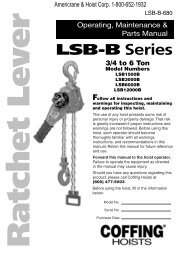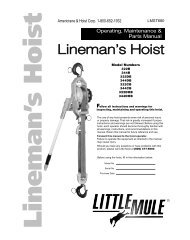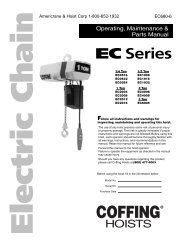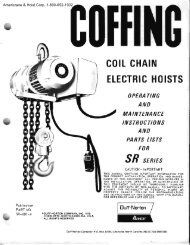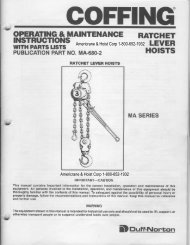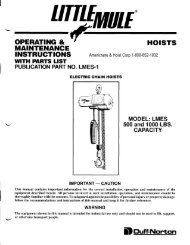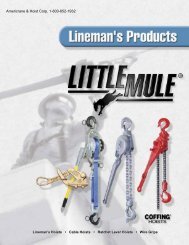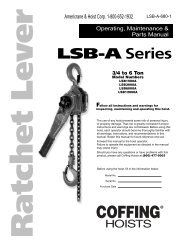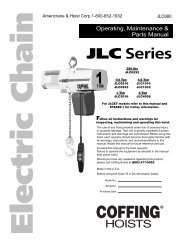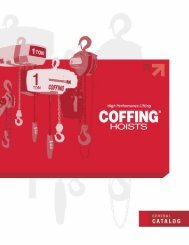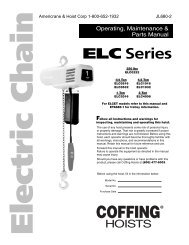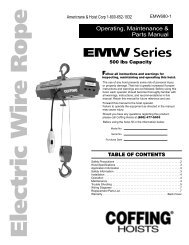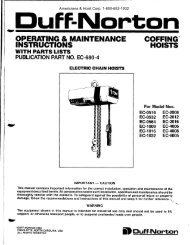ELCMT Series, JLMT 680-1 - Coffing Hoists, Coffing Hoist Parts
ELCMT Series, JLMT 680-1 - Coffing Hoists, Coffing Hoist Parts
ELCMT Series, JLMT 680-1 - Coffing Hoists, Coffing Hoist Parts
- No tags were found...
Create successful ePaper yourself
Turn your PDF publications into a flip-book with our unique Google optimized e-Paper software.
Country Club RoadP.O. Box 779Wadesboro, NC 28170 USATEL: (800) 477-5003FAX: (800) 374-6853HOIST TROUBLE SHOOTING CONTINUEDAlways disconnect unit from the power supply system before removing hoist covers or the back cover of control station.––– Probable Cause ––– ––– Remedy–––Lack of proper lifting speed1. <strong>Hoist</strong> overloaded 1. Reduce load to within rated capacity of hoist.2. Brake dragging 2. Check for proper brake adjustment or other defects.3 Low voltage 3. Ensure that the voltage at the reversing contactor is within ±10% of the nominal voltage while lifting a load.4. Overload limiting clutch intermittently slipping 4. Replace overload clutch assembly.Motor brake noise or chatter (while starting hoist)1. Brake needs adjustment 1. See BRAKE ADJUSTMENT, page 11.2. Low voltage 2. Ensure that the voltage at the reversing contactor is within ±10% of the nominal voltage while lifting a load.Motor brake “buzz” (anytime hoist is running)1. Brake needs adjustment 1. See BRAKE ADJUSTMENT, page 11.2. Broken shading coil on brake frame 2. Replace shading coil or complete brake frame assembly.Trolley does not operate1. No voltage at trolley 1. Mainline or branch circuit switch open; branch line fuse blown or circuit breaker tipped. Close, replace orre-set. Check for grounded or open connections in supply lines or current collectors.2. Open control circuit 2. Open or shorted windings in transformer or reversing contactor; control station switch contacts not making contact;loose connection or broken wire circuit. Check continuity and repair or replace defective parts.3. Wrong voltage or frequency 3. Check voltage and frequency of power supply against the rating on the nameplate of the motor.4. Low voltage 4. Ensure that the voltage at the trolley contactor does not drop below 10% of the nominal voltage.5. Excessive load 5. Reduce load to within rated capacity of unit.6. Faulty SINPAC ® starting switch or start capacitor 6. Replace faulty component.(single phase trolleys only)Trolley operates in one direction only1. Open control circuit 1. Open or shorted windings in transformer or reversing contactor; control station switch contacts not making contact;loose connection or broken wire in circuit. Check continuity and repair or replace defective parts.Trolley operates sluggishly1. Excessive load 1. Reduce load to within rated capacity of hoist.2. Low voltage 2. Ensure that the voltage at the trolley contactor does not drop below 10% of the nominal voltage.3. Worn or dirty rails 3. Clean rails, inspect for worn spots.Motor overheatsTROLLEY TROUBLE SHOOTING––– Probable Cause ––– ––– Remedy–––1. Excessive load 1. Reduce load to within rated capacity of hoist.2. Low voltage 2. Ensure that the voltage at the trolley contactor does not drop below 10% of the nominal voltage.3. Extreme external heating 3. As the ambient temperature rises towards the 130°F limitation of the unit, frequency of trolley operation must belimited to avoid overheating of motor. See ADVERSE ENVIRONMENTAL CONDITIONS, page 3.4. Frequent starting or reversing 4. Excessive inching, jogging or plugging should be avoided since this type of operation will drastically shorten the lifeof motor and contactor. Always allow the trolley to coast to a stop before reversing its direction.23



